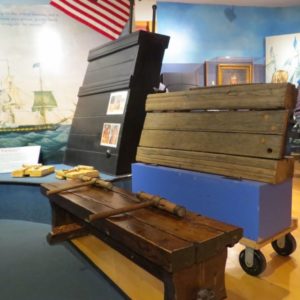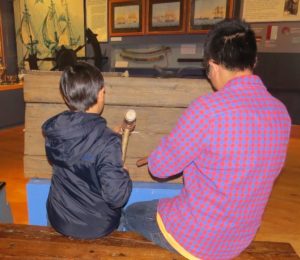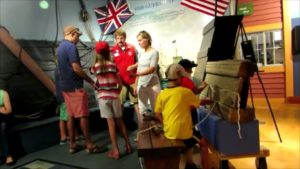Program Description
Families who participate in this drop-by gallery program are able to try their hand at caulking, or waterproofing, a ship’s side. Historically, wickum (cotton) and oakum (tarred rope pieces) were hammered into the ship’s seams and covered with pitch to seal them. This historic process is still done on board USS Constitution today. Facilitators provide the instruction and context for the activity.
Authentic and Distinctive
To keep out water, any wooden vessel needs some sort of caulking in the seams between wooden planks. Waterproofing was a job for both shipwrights and crew members aboard the USS Constitution. Tools of the Trade: Caulking provides families with the opportunity to experience this job first hand. Using period tools, including caulking mallets and irons, and authentic materials like wickum and oakum, facilitators guide families through the three-step process of caulking on a reproduced ship side. The addition of the ship’s side helped people understand what they were doing, especially when set up in a tableau of Constitution’s hull in battle. Being intentional about the environment of the program is yet another way to create a more authentic experience for families.

Multi-Modal
This Caulking program appeals to multiple learning styles. Those who prefer hands-on and doing can have a sensory experience by smelling the tarred rope and feeling the wickum or caulking the ship’s side. Others can read and examine the surrounding exhibit panels for related information.
Accessible
Early versions of this gallery program featured all elements on a large table, with a facilitator positioned behind it. This flat plane limited the number of participants, blocked the view of others, and caused many adults to hang back while children completed the activity. To make our caulking activity more accessible we made several adjustments. The addition of a ship’s side allows us to prop up the caulking area and create a larger work area with multiple levels. Now, families naturally work side by side to complete their task. There are also a variety of tools available so that younger children have appropriately sized tools and anyone can participate comfortably.

Multi-User
Eye-contact which each adult and child is always crucial to make everyone feel they are a part of the program. Facilitators also send a multi-user invitation with their language, for example: “Caulking was often done in pairs, so you’ll be working together.” They are sure to give materials to both children and adults to touch or smell. It’s an easy, non-threatening way of maintaining everyone’s involvement.
There are multiple ways of being involved with the caulking process. If an adult or child does not want to try caulking, a facilitator invites them to roll the oakum so that they are engaged in the process. Finally, the addition of tools that are accessible to different ages and abilities are silent invitations for all to participate.

Encourage Conversation
The design of this activity- with the ship’s side propped up- encourages conversation between family members because it is visible to all participants. Whether caulking the side, rolling oakum, or interacting with some of the reproduction items and images, the variety and position of materials are designed to get families interacting with each other and this historical process.
Conclusion
The Tools of the Trade: Caulking program offers families the chance to work together to try a distinctive process. Offering the program in an authentic environment, sending invitations to participate through verbal and physical cues, and adjusting elements so that they are accessible to all ages and abilities creates an intergenerational experience that enriches family visits to the museum.
